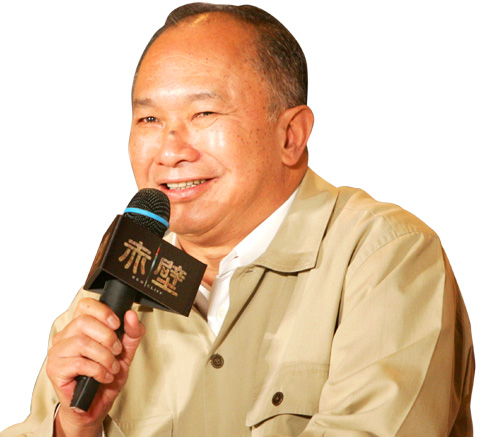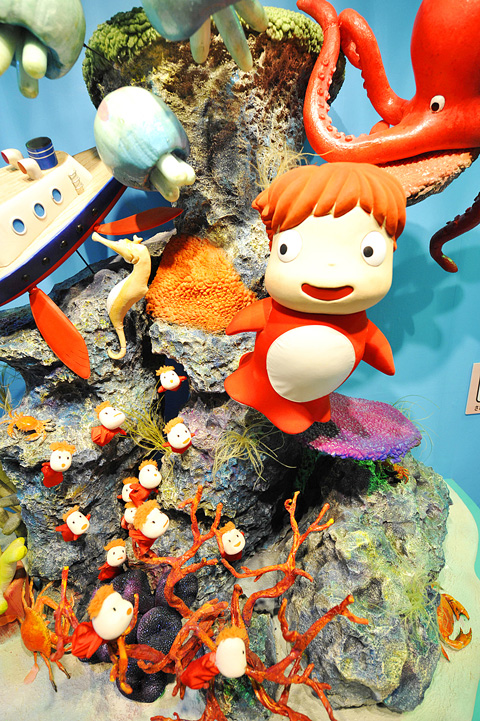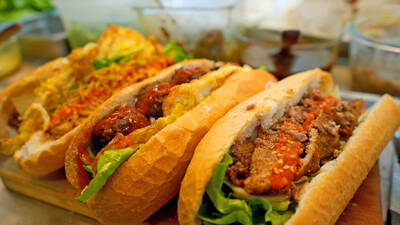The John Woo (吳宇森) epic Red Cliff (赤壁), dubbed the most expensive movie made in Asia, enjoyed record takings for a Chinese film in its opening weekend in China, the movie's distributor said on Wednesday.
The film, which depicts events in the ancient Three Kingdoms period, made US$16 million in China in the four days after its debut last week, said a China Film Group spokesman.
The box office takings beat other previous domestic blockbusters such as Curse of the Golden Flower (滿城盡帶黃金甲), directed by Olympic opening ceremony mastermind Zhang Yimou (張藝謀), as well as Taiwanese director Ang Lee's (李安) Crouching Tiger, Hidden Dragon (臥虎藏龍), Xinhua news agency said.

PHOTO: AP/TULSA WORLD
Woo, a Hong Kong film director and producer, rose to international prominence with Face Off starring John Travolta and Nicolas Cage in 1997.
He was also the director of Mission: Impossible II starring Tom Cruise.
Oscar-winning Japanese animator Hayao Miyazaki releases his first full-length film in four years this weekend, dropping computer graphics for his pencil to tell the story of a fish-girl and the sea.

PHOTO: AFP
Ponyo on the Cliff by the Sea, which the reclusive 67-year-old both wrote and directed, will hit screens at cinemas across Japan tomorrow after weeks of intense media interest.
Inspired by the 19th-century fairy tale The Little Mermaid by Danish author Hans Christian Andersen, the story centers around a tiny fish-girl, Ponyo, who rides a jellyfish to escape her home in the sea.
She meets a five-year-old human boy, Sosuke, who vows to protect her, but Ponyo is taken back to the sea. Desperate to be a human and live with Sosuke, Ponyo heads to land again with help from her sisters.
Miyazaki is one of Japan's biggest cultural exports. His last film, Howl's Moving Castle, broke opening box office records at home in 2004 before winning a cult following in Western and Asian nations.
Miyazaki, who had used computer graphics since Princess Mononoke in 1997, decided to shun hi-tech effects in his latest film.
"Our experience told us that what you can do electronically doesn't impress people much. We decided to go fully with pencils ... That's our strength," he said in a recent interview with Japanese public broadcaster NHK.
The film used 170,000 hand-drawn pictures to animate characters and objects, a record number for a Miyazaki production.
It took one and a half years for 70 staff to draw the pictures, according to Studio Ghibli, which has released his works.
Sony Corp will increase the storage capacity of its PlayStation 3 video-game console starting in September, following a similar move by Microsoft earlier this week.
The storage space on Sony's console will double to 80 gigabytes, Jack Tretton, head of Sony's US games unit, said on Tuesday. Sony also will offer movies from major studios for sale or rent through its PlayStation 3 and PSP video-game players, Tretton said.
The Class, winner of the Palme d'Or at this year's Cannes Film Festival, will open the 46th annual New York Film Festival.
The Film Society of Lincoln Center, which produces the festival, announced on Tuesday that it will give the opening night honor to Laurent Cantet's drama about classroom life at a French junior high school.
The docudrama was shot with real students and teachers in a raw, improvisational style to chronicle the drama that unfolds over one school year. The Class (Entre les Murs) was unanimously selected for the main prize at Cannes by a nine-member jury headed by Sean Penn.
It's the second film by Cantet to play at the New York Film Festival; his acclaimed Time Out was shown in 2001.
"Laurent Cantet has pioneered a new kind of social cinema,'' said selection committee chairman Richard Pena in a statement. He continued that it is a style "that explores the key issues of our day, from contemporary labor struggles to First World/Third World relations and now to education.''
This year's festival, which runs from Sept. 26 through Oct. 12, will be held at the Ziegfeld Theater due to ongoing renovations at the event's traditional home, Alice Tully Hall at Lincoln Center.

We lay transfixed under our blankets as the silhouettes of manta rays temporarily eclipsed the moon above us, and flickers of shadow at our feet revealed smaller fish darting in and out of the shelter of the sunken ship. Unwilling to close our eyes against this magnificent spectacle, we continued to watch, oohing and aahing, until the darkness and the exhaustion of the day’s events finally caught up with us and we fell into a deep slumber. Falling asleep under 1.5 million gallons of seawater in relative comfort was undoubtedly the highlight of the weekend, but the rest of the tour

Youngdoung Tenzin is living history of modern Tibet. The Chinese government on Dec. 22 last year sanctioned him along with 19 other Canadians who were associated with the Canada Tibet Committee and the Uighur Rights Advocacy Project. A former political chair of the Canadian Tibetan Association of Ontario and community outreach manager for the Canada Tibet Committee, he is now a lecturer and researcher in Environmental Chemistry at the University of Toronto. “I was born into a nomadic Tibetan family in Tibet,” he says. “I came to India in 1999, when I was 11. I even met [His Holiness] the 14th the Dalai

Following the rollercoaster ride of 2025, next year is already shaping up to be dramatic. The ongoing constitutional crises and the nine-in-one local elections are already dominating the landscape. The constitutional crises are the ones to lose sleep over. Though much business is still being conducted, crucial items such as next year’s budget, civil servant pensions and the proposed eight-year NT$1.25 trillion (approx US$40 billion) special defense budget are still being contested. There are, however, two glimmers of hope. One is that the legally contested move by five of the eight grand justices on the Constitutional Court’s ad hoc move

Stepping off the busy through-road at Yongan Market Station, lights flashing, horns honking, I turn down a small side street and into the warm embrace of my favorite hole-in-the-wall gem, the Hoi An Banh Mi shop (越南會安麵包), red flags and yellow lanterns waving outside. “Little sister, we were wondering where you’ve been, we haven’t seen you in ages!” the owners call out with a smile. It’s been seven days. The restaurant is run by Huang Jin-chuan (黃錦泉), who is married to a local, and her little sister Eva, who helps out on weekends, having also moved to New Taipei